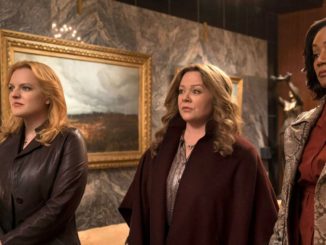
By Kristin Marguerite Doidge
When other unscripted series’ production teams decided to zig this past year, the producers behind “The Circle” chose to zag.
The popular Netflix social media competition series was previously being shot and edited in the U.K., but recently came to the U.S. for seasons six and seven (the latter yet to be aired) under an IATSE contract – a huge win for the talented team of editors working on the show.
“At a time when reality television, especially, has had a lot of trouble keeping shows in the States, and with production and post-production declining, the fact that Studio Lambert made a decision to go in the opposite direction and bring it here, is, I think, a wonderful, beautiful thing,” said lead picture editor Jeremy Walters. “It was a grind, don’t get me wrong, but I think you had some of the most talented reality, non-reality, docu-reality people working on this playing multiple roles and taking it from literally hundreds of hours of raw and, within days, turning it into a show.”
Indeed, “The Circle” presented a unique set of challenges, not only due to an über-accelerated 24-hour schedule with editors both on-site in Atlanta and working remotely from Los Angeles, but also creatively, because of its very different storytelling style, said editor Julie Antepli, ACE, who served alongside more than 30 other editors on season six.
“The concept of the show was established early on during the pandemic, so it had players joining a social media circle from their apartments,” she explained. “Some play as themselves, while some are catfish, as they try to win a cash prize of $100,000. We had all of the editors in each episode working like a ‘relay race,’ transforming raw footage of players talking to themselves and texting one another and editing them as if they were all having conversations together.”
CineMontage recently spoke with Walters and Antepli to learn more about how the post team worked together to deliver the show quickly and creatively.
CineMontage: How did you begin to tackle the unique structure of this particular show, with players talking to themselves in isolation?
Walters: First of all, I think the big thing to mention is that production moved to the US from the UK. The first five seasons were overseas, even though the show was essentially a US show, meaning that they filmed a lot of b-roll and tried to make it seem like a nondescript city, and yet they always used the same exteriors for the one complex where supposedly everybody lived in the building.
Seasons six and seven – which were filmed back-to-back – were both brought into Atlanta. They used a full Atlanta crew. I’d say about two-thirds of the editors were based out of LA and working remotely, and they had about 11 editors (or about a third) that wound up in Atlanta working there on set actually. I became involved through executive producer Susan House, who Julie and I have worked with several times in the past on shows like “The Bachelor,” “The Toy Box,” and “The Hustler.” She’s amazing, and she was really trying to steer it more towards the American flavor, if you will.
Antepli: We had a general idea of what the trajectory of an episode was in terms of who might be eliminated, or there will be some drama between these two people, things like that. That’s kind of like a goalpost for us as editors, but we had to take hours and hours of footage, as Jeremy mentioned, like nine cameras, but also each player being in their own apartment talking to themselves or talking to a producer for hours.
My day would start and I would take a string of raw footage that’s sometimes six hours, and I’d find ways to get through it as quickly as possible. One of the things that you do is you put wave forms up to see where nobody’s speaking, so nothing’s happening – you just chop those out. And then sometimes I listen to things in double time just to get through it, and if I hit the spot where something was interesting, I would just slow it down and do my selects and things like that.
CineMontage: What was the workflow like – and what made it different from other shows you’ve worked on?
Walters: What’s fascinating is that the execs from Netflix were on set, so that’s one of the reasons we were able to turn over the notes so fast. They watched footage from each show three times a day to help guide last minute story or character changes. We’d get the rough cut out, they would screen it on-site, give notes, then go to the next series of notes.
We had five finishers working on each round of notes from the EPs and Netflix, and those finishers worked on story, GFX, music, etc. This really was a huge team effort, and from assembly to polish, there were so many incredible, talented people working diligently from assembly, to rough cut, to stitching, to finish. And then, after the finishers, I did the final rounds of notes and a pass on story changes, pacing, GFX, and music before it went to online.
Antepli: Another interesting thing was we actually had almost a week of rehearsals, and that included rehearsing the editorial as well, which is unheard of, but also that speaks to how complicated and crazy the show was. By the time we got the actual footage, everybody was ready to hit the ground running with no hiccups.

We had editors like myself who were the builders. We built the scenes and then we would pass them on to somebody or multiple people who would be what we call a stitch editor. They would assemble the show so that they could be screened, and then they would be passed down to finishing editors for the notes process. And then Jeremy would come in for finishing and polishing, putting the final gloss on everything, so it was multiple steps to get there and everything was super fast.
CineMontage: What were you particularly proud of with this particular season?
Antepli: Our entire show is based on people texting. We did have games and things like that, but it’s all on social media, so how do you make it interesting? That’s where our creative challenge laid in terms of trying to find the most amazing reactions. It was a lot of back and forth with nailing it so that we’re hitting the story points while making it interesting and exciting and fun.
We would be assembling a scene and sometimes the message exchange wouldn’t quite track with the overall story of the episode. So we would go back and craft the message exchange – let’s say losing some texts or changing the order of some texts, but then how do we seamlessly get back to the conversation so that the text exchange still makes sense? That wasn’t something that the producers manipulated or produced. Every reaction was real. It was great casting of course, which helps.
CineMontage: How did the AI bot fit in with these challenges in seasons six and seven?
Walters: Regarding the AI bot, I think we timed it just right. I think if we had done it a season or two later, it would’ve been too late – the allure, the shine of AI was right at the right moment. It did create its own problems because the game was to be played fairly, but I think there were choices made in terms of how far you let the AI run, giving it certain parameters on how it’s going to participate. I think that was the biggest challenge.
And let’s be honest, as editors, it’s just a shot of a box, so how do you make it feel like it’s a character? How do you bring that out? We had a lot of people working really hard to tell the story, pick the right music, and get the messages across and the reactions. A lot of what that was playing off of other people’s response to the box talking, because the box isn’t really emoting. There’s no emotion to read. So it was a little bit different, I think, than some other portions of the show.
With regard to season seven, I feel like the best elements of what we’ve been doing in the last few seasons, not just the ones we did for six, but before in terms of gameplay, in terms of style, in terms of the fun elements of the show, I think we’re pushing it even further. We take catfishing another couple steps and really make it as entertaining as we can. I think it’ll be fun to watch, for sure.
CineMontage: How did the IATSE contract help the editing team achieve their goals for the show?
Walters: I think through the ‘power of union,’ quite literally that term and the union [Guild] itself, is that it was going to hold things together. I think to do this as a non-union show would be very difficult to manage and control and keep everything regulated.
The hours that were put in by some of the staff were incredible. What they did within the time that they were given was also incredible. I have, in the past, made jokes about edit schedules. If something is supposed to take, I don’t know, one editor six to eight weeks to get to a rough cut, the adage has always been, ‘well, you get two editors and you’ll do it in four weeks. You get four, you’ll do the rough cut in two weeks.’
For this, it was: how many editors can we get on it at one time? Can we cut the thing in a day or two? And that’s literally what happened. So it showed what really should have taken, I don’t know, six to eight weeks to really get to a final cut stage we’re doing in 48 hours. That’s crazy to do because of storage issues, but remember, we actually did two seasons back to back. We were running all the cameras all the time, 24 hours a day, just to control this media, and that was a lot of what the assistant editors did as well. We had media managers there, too, but thank God for the union, because I think if you didn’t have that, I think if you didn’t have a set of rules and you didn’t have people working together and having an understanding – even as a handshake – I don’t think it could have functioned as efficiently as it did.
This interview has been edited for length and clarity.




